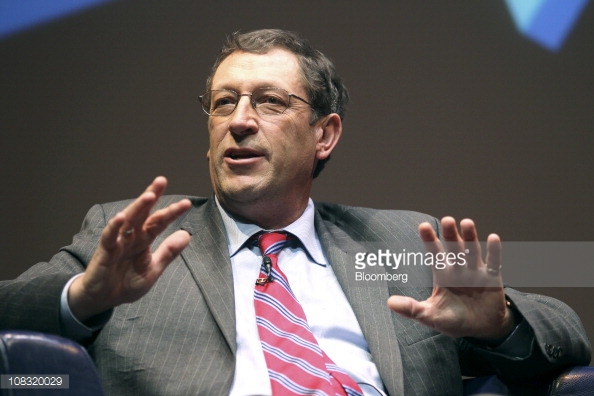‘Danny’ Blanchflower on Brexit and Trump: a report of a public lecture, University of Stirling, 8th December, 2016
Kevin Ralston, University of Edinburgh, 2016

(Danny Blanchflower on Bloomberg TV)
‘It’s the labour market stupid’ was a refrain in a lecture given by professor Blanchflower on Brexit and other surprises. It’s the labour market stupid is also the title of his next book.
David ‘Danny’ Blanchflower is an academic and economist whose work carries well beyond the Ivy League university in which he has a chair endowed. He sat on the Bank of England’s Monetary Policy Committee across the period of the financial crash 2006 to 2008 and is currently a visiting scholar at the Federal Reserve in Boston. In the UK he regularly writes for the Guardian and works for the U.S. based financial news broadcaster, Bloomberg, indeed he was live on TV as the UK voted for Brexit. His opposition to Brexit led Michael Gove to tweet him during the course of the campaign to accuse him of being ‘mugged by reality’. In this crossover to the mainstream Blanchflower is one of those larger than life academics, whose personality combines with an intellectual capacity that has given his views a platform, that many aspire to, but few reach.
As well as being a Professor of Economics at Dartmouth, he is a part-time professor at the University of Stirling. This connection is what brings someone who is, by any standards, an academic heavyweight, to a relatively obscure corner of Scotland, to give a public lecture on a cold, dark, December evening.
Danny’s thesis is that the Brexit vote, and the support for Trump, is explicable by many in the economy having been left behind, especially following the Great Recession of 2008. He cites evidence drawn from several sources throughout the talk.
The argument is compelling. Nine million of the working aged population are indicated to have disappeared from U.S. labour force statistics. Following the economic collapse, underemployment has become a particular feature of the UK economy, with data showing part-time workers, and the self-employed, craving more hours.
This is contrary to the Governments of U.S. and UK and their absurdly jaundiced insistence that we are basking in some version of full employment. A political strapline cannot deny the lived experience of people on welfare, regardless of how quickly life went back to normal for the elites following the 2007/08 crash.
A fundamental rule of economics is that rising employment drives up wages. A simple supply and demand system. Blanchflower shows wages are stagnating. In the UK wages are 7% down from their peak, in the USA real wages are below what they were in 1973 for the typical worker. No wage growth means there is no full employment. This is regardless of how the figures are massaged, and the bad news disregarded, to maintain a political mantra that the economy is performing well.
Special disdain is reserved for government economists and politicians who are considered to have lost all economic credibility. Apart from their denial of the realities of the labour market, this group are guilty of what the Danny describes as ‘fingers crossed economics’. This is characterised by the insistence on projecting forecasts that bear no association with reality. A central part of this is repeated assertions, over years, that interest rates will rise along with wages. Blanchflower shows official wage projections predicting four percent plus wage rises across years when growth was, at best, two percent. In addition the markets have been repeatedly told interest rates will rise in stages over time, but they have necessarily remained close to zero. The result of repeatedly promising one thing but delivering another is that that no one believes these forecasts anymore. Whatever credibility the establishment economists and politicians ever had has ebbed away in the decade following the crash.
The upshot of all of this is that many have been left behind by the economic collapse, out of work, underemployed and worse off than they were before the downturn. Those who have been left behind are far more likely to have voted for Brexit or Trump. Some of the figures are startling. Lower wages explains forty-six percent of the variance in accounting for a vote for Trump, male obesity explains seventeen percent. In the U.S. the older, white, less educated and poor, were more likely to back Trump. The unemployment rate amongst men aged 25-54 with no college education is 20% in the U.S.A. If you are one of these people what choice do have? If the elites practice ‘fingers crossed economics’, can we blame these people if they engage in fingers crossed politics?
The parting shot is that confidence in the UK has collapsed. All regions now report the outlook as dramatically worse than they did a few months ago. Responses to a survey question on whether the economic prospects for the next ten years have gotten better or worse illustrates the stark decline. In July 2016, before the referendum, the South East (of England) was responding positively to a ten year forecast at +8, by August this has haemorrhaged to -30. In Scotland the pessimism knows no bounds, with a gloomy -28 in July nosediving to a despair inducing -42.
Things could not get much worse! Except they could and Danny is not sure that we can expect our elite leaders to do the right things to get us out of this. He points out, the OECD suggests the UK to be one of the best placed countries to introduce fiscal stimulus, funding investments with deficits to offset the massive loss of wealth we have just gone through, but the Chancellor refuses to act.
Maybe, just maybe, Blanchflower muses, to a question from the audience, Trump will issue a 30 trillion dollar bond and build, educate and invest the U.S.A. out of the decade long semi-slump that has followed the recession, maybe. Unfortunately it is hard to leave this lecture without feeling we have all been mugged by reality and the consequences of this are only just beginning to be felt.
